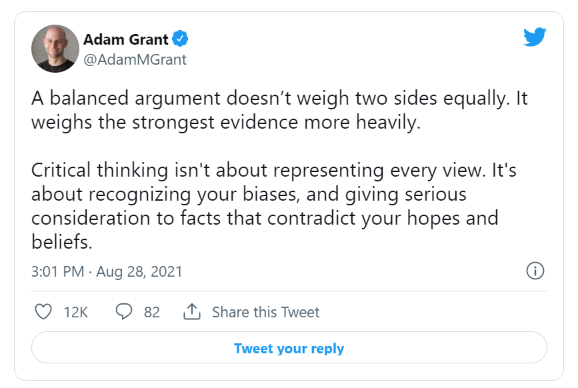5 Nov 2021
Negotiating Day and Night: How To Negotiate and Make Trade-offs as a Product Manager
Communication, Relationships, and StakeholdersYou may not know it, but you’re a full time negotiator.
Take a moment to think about it. Most of our interactions involve some level of negotiation. You negotiated your salary. If you rent an apartment or own a home, you probably negotiated rent or buying price. There's a very good chance you negotiated what movie or TV show you and your partner watched last weekend.
In the words of expert negotiator Chris Voss, “Life is a negotiation”.
Negotiating eday and night
If you’re a product leader, you’re negotiating in overtime. This is because it's critical to building impactful products. We constantly prioritize work and make trade-offs. We seek to positively influence stakeholders to buy into our vision.
Negotiating and making trade-offs doesn’t need to be scary. It is an every day part of life, especially as a product manager. You can improve your approach by:
Actively listening to others
Seeking to understand your audience
Asking questions and using data to support viewpoints
Using prioritization frameworks to support your vision where useful

What is negotiation?
Negotiation is about communication skills and facilitating decision making.
Negotiation involves gathering information and communicating with clarity to influence and achieve results. It’s about listening to others, asking good questions and making a clear case for something you want to achieve. This applies whether it’s asking for a raise or seeking buy-in to your product strategy. Negotiation doesn’t mean:
Engaging in conflict
Seeing to treat others unfairly or to “screw them over”
Aggressive communication tactics
Trying to submit others to your will
Not listening
Unfortunately, there are people who don’t negotiate well and engage in some of the above tactics. These people give negotiation a bad name. But don’t let that ruin it for you. It’s very much within reach to negotiate fairly and with integrity.
Why is negotiation and trade-offs important to product management?
I’ve spoken briefly about how as a product leader, negotiation is a big part of the job. Why is that?
1. Your job is to prioritize
One of the most important skills in product management is the ability to prioritize and make trade-offs. Prioritization makes or breaks your product.
Prioritization requires you to look at the relative importance of work to decide what will deliver the most value. Product people draw on different team members and data to do this prioritization. This involves asking the right questions and listening carefully to make decisions about the product.
Part of this decision making means weighing up different options and opinions. Healthy product teams have discussions about the pros and cons of different approaches. Different team members and stakeholders will have opinions about what’s most important and impactful. They might advocate for different solutions. It’s the product manager’s role to understand them all and guide the team towards a decision. Doing this is a negotiation. Why? Because this process inevitably involves a give and take between different viewpoints.

2. You need to influence stakeholders and get buy-in
Another vital part of product management is getting stakeholders to understand product decisions and buy into them.
Product managers need leadership to understand why a problem is worth solving. You also need to communicate how you and your team intend to solve it. If you fail to do this, you may be stopped in your tracks.
For example, product managers need stakeholders to buy-in to their roadmaps. This means communicating your roadmap to key stakeholders by telling a compelling story about where you're going. You’re effectively trying to influence stakeholders to achieve the goal of alignment and buy-in. Validating your team’s roadmap means you can start to deliver against it.
How to negotiate and make tradeoffs
So, how do you improve your approach? Below are some key areas to work on to become a better negotiator.
1. Actively listen to others
So many of us want to hear what we want to hear. We often find it easier to stick to what we already believe.
To negotiate and make trade-offs as a product manager, you need to extract as much information as possible. New information will allow you to validate or invalidate assumptions. Think of each invalidated assumption as a step forward in negotiations.

To improve your negotiation skills, try suspending your preconceived ideas and practice active listening. Active listening means pausing your own internal thoughts and actually paying attention to what the other person is trying to convey.
Many people approach negotiation and prioritization discussions preoccupied by what they’re going to say to support their position. But doing this means you're distracted by what you’re going to say next and unable to listen attentively. Really listen and hear people out to better understand their position.
2. Understand your negotiating counterpart
If you understand who you’re speaking with, you’ll be able to create buy-in. The process of influencing for buy-in is fundamentally a negotiation.
People have different goals, motivations, and challenges. Try to understand them. This way, you’ll be helping them understand your message and key points that you’re trying to get across. Your views will be far more influential if they resonate and are meaningful to the people you’re communicating with. If you’re unsure how to get to know people’s goals and challenges, simply set up some conversations with them to understand their needs and challenges.
If you are very unfamiliar with the person you want to influence (and perhaps work in a larger organization), you can approach your conversations with more structure (some people refer to these as stakeholder interviews). Consider some guidelines to prepare for them. I recommend reading Erika Hall’s Just Enough Research to help guide these conversations.
Create empathy with the people you’re discussing and understand how they relate to your product and team. This will ensure your discussions resonate with them and will enable you to get the buy-in you need.
3. Ask questions, seek data
Product management is not a science. We can never be exact about the trade-offs we make. However, it is your job as a product manager to validate assumptions and de-risk initiatives. The more data you have, the more informed the trade-off.
Seek out data to support different approaches and points of view. For example, if a developer is keen for the team to spend time fixing a bug, you should interrogate the impact of the bug. Does it affect all users? A small subset? Does it get in the way of a core journey or is it something negligible?
Avoid resorting to ‘gut feel’ and look for information that can support good decisions.

4. Use prioritization frameworks to support where useful
As a Product Manager you are often weighing up multiple initiatives and features at a time. This means being in constant negotiation with several stakeholders and disciplines.
Frameworks can help you make sense of the great number of ideas, initiatives and stakeholder requests coming your way. Putting a framework in place serves several benefits. In addition to allowing your team to focus on the right things, a good framework:
Empowers your product team to filter out data points or requests that aren’t of significant value or are simply gut-based, leading to objective decision-making.
Helps you positively influence stakeholders because you’ll be able to engage in an objective conversation and mitigate the risk of HiPPO- based decision making.
Select a prioritization framework (and there are many) that works for your team and organization. While they help shed objective light on the features and initiatives you’d like to measure keep in mind that there are other external factors that need to be considered at times, such as dependencies, the dynamics of the competitive landscape and budget cuts or limitations, to list just a few examples. But nowhere in this list of external factors should “gut feel” or “because I said so” appear!
Life is one big negotiation. If you’re a product manager this is even more the case for you!
Negotiating and making trade-offs is vital to making good product decisions and building impactful products.
Negotiation isn’t about “getting what you want at all costs”. Rather, good negotiators gather information and influence outcomes. To negotiate well and make good tradeoffs, practice active listening to make sure you’re listening out for important information and removing bias. Seek to understand your audience so that your message is meaningful to them. This will increase your chances of positively influencing them. Use data to make informed trade-offs and remove gut feel from the equation. Finally, consider prioritization frameworks to support making tradeoffs.
I recommend Never Split the Difference by expert hostage negotiator Chris Voss to learn more about negotiation.

Hilary Johnson

Read also
Experience the new way of doing product management







